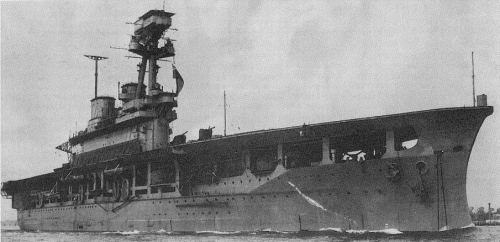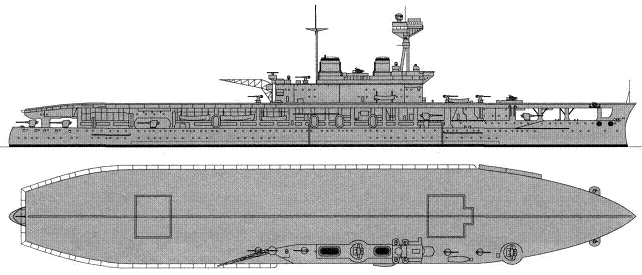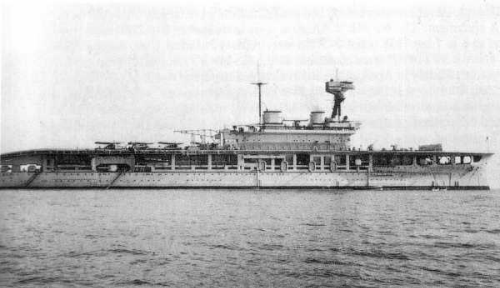
NAVYPEDIA
 Support the project with paypal
Support the project with paypal
Photo

Eagle 1923
Ships
| Name | No | Yard No | Builder | Laid down | Launched | Comp | Fate |
|---|---|---|---|---|---|---|---|
| Eagle (ex-Almirante Cochrane) | 94 | 858 | Armstrong, Elswick | 20.2.1913 | 8.6.1918 |
4.1920 (officially) 9/1923 (really) 26.2.1924 (finally) |
sunk 11.8.1942 |
Technical data
| Displacement normal, t | 22960 |
|---|---|
| Displacement full, t | 26800 |
| Length, m | 203.5 |
| Breadth, m | 32.0 |
| Draught, m | 8.10 deep load |
| No of shafts | 4 |
| Machinery | 4 sets Brown-Curtis geared steam turbines, 32 Yarrow boilers |
| Power, h. p. | 50000 |
| Max speed, kts | 22.5 |
| Fuel, t | 2990 oil |
| Endurance, nm(kts) | 4000(18) |
| Armour, mm | belt: 114 - 25, bulkheads: 102, deck: 38 - 25, gun shields: 76 |
| Armament | 9 x 1 - 152/50 BL Mk XVII, 4 x 1 - 102/45 QF Mk V, 25 aircraft (Nightjar, Plover, Flycatcher fighters, Panther, Walrus, Bison, Blackburn recon planes, Dart torpedo bombers) |
| Complement | 950 |
Air group
| Year | Fighters | diving bombers | torpedo bombers | recon planes |
|---|---|---|---|---|
| 1935 | 9 Osprey | --- | --- | 12 Fairey III |
| 9.1939 | --- | --- | 18 Swordfish | --- |
| 6.1940 | 3 Sea Gladiator | --- | 18 Swordfish | --- |
| 12.1940 | 3 Sea Gladiator | 2 Skua | 18 Swordfish | --- |
| 2.1941 | 3 Sea Gladiator, 2 Fulmar | --- | 18 Swordfish | --- |
| 5.1941 | --- | --- | 18 Swordfish | --- |
| 10.1941 | 2 Sea Hurricane | --- | 18 Swordfish | --- |
| 1.1942 | 16 Sea Hurricane | --- | 18 Swordfish | --- |
| 6.1942 | 16 Sea Hurricane | --- | --- | --- |
Standard scale images

Eagle 1939

Eagle 1920
Graphics
Aircraft facilities
(fd - 5,822 m², ha - ~ 2,438 m² / 10,483 m³): Flight deck: 198.7x29.3 m; hangar: 121.9x20.0m; 2 lifts (6.4 t), 1 crane for seaplanes
Project history
This ship was ordered for Chilean Navy as battleship Admiral Cochrane. She was requisitioned by Admiralty at the First World War beginning, in the end of 1917 the decision to complete her as an aircraft carrier was accepted. Eagle was planned to commission in 1919, however building was delayed till February, 1924 because of considerable changes in the design (conversion of boilers to oil firing, fitting of anti-torpedo bulges, changing of armament: number of 152mm guns had decreased from 12 to 9, lengthening of the island for better aerodynamic properties). First time there was the "longitudinal" system of arresting gear, removed in 1926.
Protection
There were bulges intended for torpedo protection. Main deck had 25mm slopes, connected with lower edge of main belt.
Modernizations
Till 1920 fuel storage was 3200t of coal and 1750t of oil, main guns consisted of 12 x 1 - 152/45mm BL Mk.XII. There were no bulges, and maximal breadth was 28.7m.
1926: aircraft fuel stowage increased to 67200l.
1927: + 1 x 1 - 102/45 QF Mk V, 14 x 1 - 7.7/87
1929: + 2 x 1 - 40/39 2pdr QF Mk II
1932: - 1 x 1 - 102/45, 2 x 1 - 40/39, 14 x 1 - 7.7/92; + 1 x 8 - 40/39 2pdr QF Mk VIII, 2 x 4 - 12.7/62
1937: + 1 x 8 - 40/39 2pdr QF Mk VIII
1942: Aircraft fuel stowage increased to 80600l; - 2 x 4 - 12.7/62; + 12 x 1 - 20/70 Oerlikon Mk II/IV, 2x type 282, type 285, type 290 radars.
Naval service
An accident has happened onboard the ship in Indian ocean 14.3.1940: 250pdr (114kg) bomb has blown up in a hangar for the unknown reason. Full repair was not possible because of urgent transfer to Mediterranean Sea, therefore the ship suffered from often breakages. She was attacked 11.8.1942 in 65nm E off Majorca by German submarine U73 and, having received hits of four torpedoes, sunk in 4 minutes, 263 people were lost.
Many thanks to Wolfgang Stöhr for additional information on this page.
 HOME
HOME FIGHTING SHIPS OF THE WORLD
FIGHTING SHIPS OF THE WORLD UNITED KINGDOM
UNITED KINGDOM AIRCRAFT CARRYING SHIPS
AIRCRAFT CARRYING SHIPS EAGLE aircraft carrier (1, 1923)
EAGLE aircraft carrier (1, 1923)

